Subphylum Vertebrata Suborder Serpentes Scientific name Elaphe Rank Genus | Phylum Chordata | |
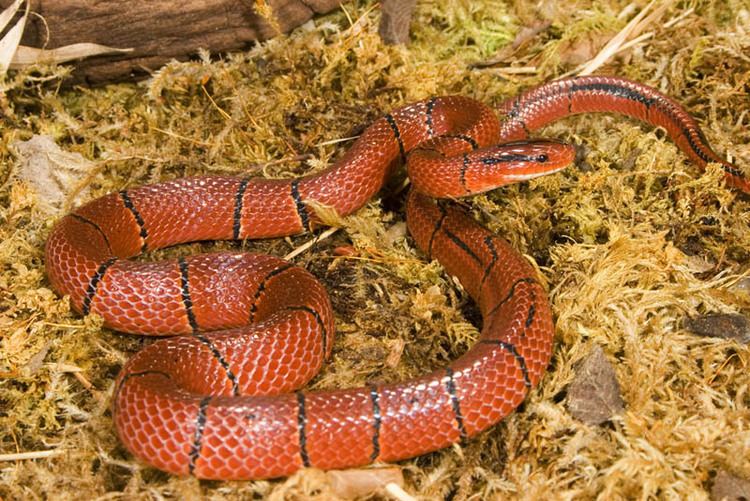 | ||
Lower classifications Elaphe schrenckii, Elaphe carinata, Four‑lined snake, Steppe rat snake, Japanese rat snake | ||
Elaphe is one of the main genera of the rat snakes, which are found in many regions of the northern hemisphere. Elaphe are medium to large constrictors by nature. All species are nonvenomous. Although all of the species in Elaphe are nonvenomous, bites from rat snakes are still irritably painful and can potentially cause bacterial infections due to the saliva.
Contents
- Ramesses king rat snake elaphe carinata
- Physical characteristics
- Senses
- Life cycle and behavior
- Hibernation
- Reproduction
- Defense mechanisms
- Locomotion
- Predation
- Habitat and distribution
- Species
- References
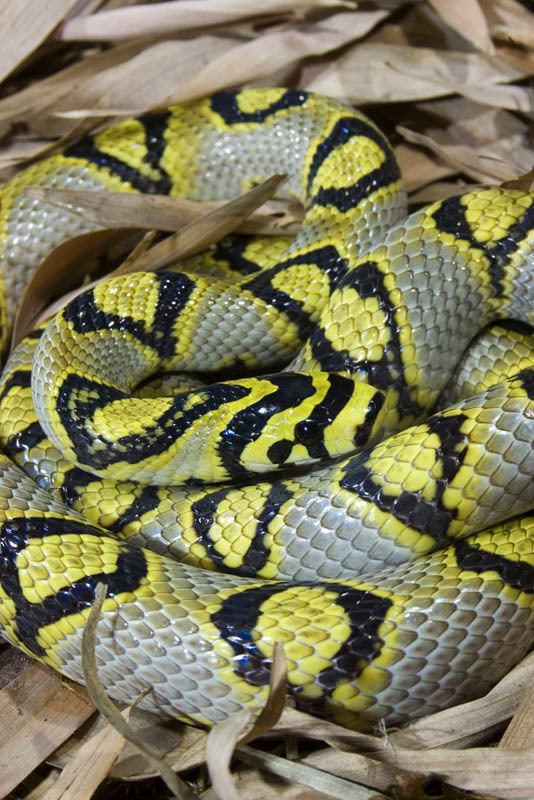
Based on the mitochondrial DNA analysis results, many species of Elaphe have been moved to the genera Bogertophis, Coelognathus, Gonyosoma, Orthriophis, Pantherophis, Rhinechis, Senticolis, Zamenis and more. Nevertheless, the name Elaphe is still widely used.
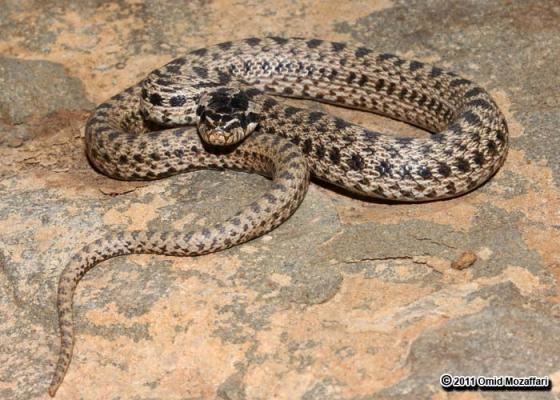
Ramesses king rat snake elaphe carinata
Physical characteristics
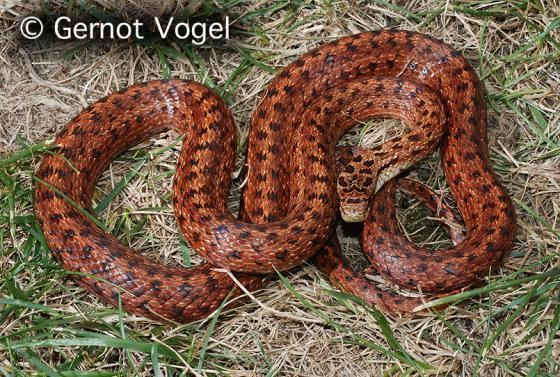
Like most of the rat snakes, Elaphe generally have slender but sturdy bodies, square heads and extremely flat bellies Their sizes range from large medium to very large, growing even as large as 108 inches. Elaphe have large numbers of vertebrae, ribs and ventral scales but few rows of dorsal scales. The dorsal scales of Elaphe are characterized by having slight keels. In cross section Elaphe are shaped like a loaf of bread, the flat belly meeting the sides of the body at an angle. This special physical characteristic is well observed in Elaphe obsoleta whose belly scales curve upward. The curving of the ventral scales renders Elaphe better traction for tree climbing.
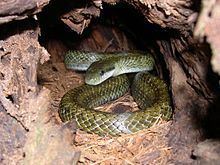
The color and pattern of Elaphe is quite variable and hard to be generalized. The following are the descriptions of the color and pattern for some Elaphe species. Elaphe guttata, or corn snakes, have arrow-shaped blotches on the head and black squarish blotches on the ventral side. The underside of the tail is striped.
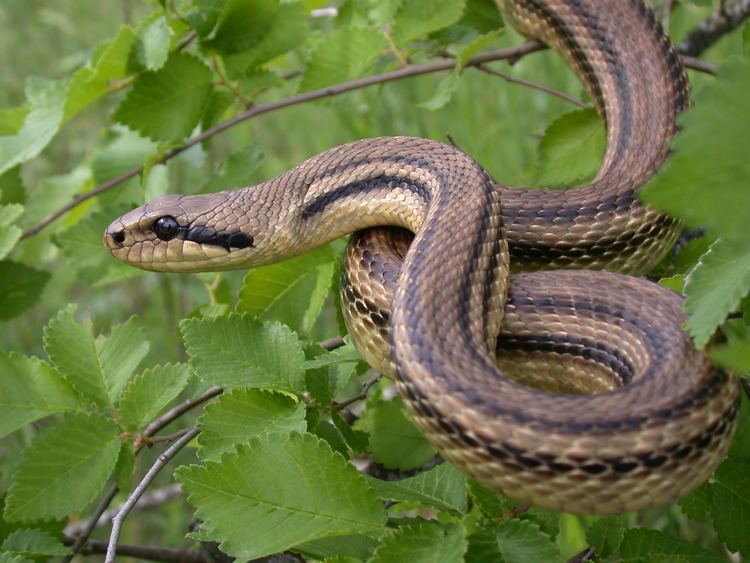
Adult black rat snakes, one of the subspecies of Elaphe obsoleta, are shiny black on the dorsal side with some yellow, white and red on the skin between the scales. The anterior ventral side, the throat and the neck, is white, while the posterior ventral side of the snake is marked with black and brown. The yellow rat snakes, a subspecies of Elaphe obsoleta, differ from the black rat snakes in that they have four bold longitudinal dark stripes. The background color ranges from dull to bright yellow.

Internally, Elaphe do not have any observable vestiges of hind limbs or coronoid bones of the lower jaw like any other members of the Colubridae family. Another important characteristic of Elaphe as part of the Colubridae is the presence of Duvernoy's gland, a modified salivary and digestive gland. In addition, Elaphe have equal and smooth maxillary teeth. The teeth are small and slightly curved and are placed in several rows. The curvy teeth help fixate the prey and prevent them from escaping once they are caught.
Senses
Elaphe have very developed sensory organs which support their daily activities. They have an internal ear that enables them to detect sounds at low frequencies. The ear consists of a single ear bone connected to a jaw bone. Compared to other snakes, Elaphe are considered to have highly developed vision that allows them to detect the movement of their predators and prey. The eyes are protected by single transparent brilles. In addition, the analysis of scents is carried out by Jacobson's organ in the palate. To stimulate Jacobson's organ, Elaphe use their tongues to transport air and ground molecules such that the molecules come into contact with Jacobson's organ. Then the organ analyzes the molecules to identify the scent. Among these detectable scents are pheromones, which indicate the presence of other snakes and their reproductive readiness.
Life cycle and behavior
The lifespan of Elaphe is generally 15 years. Males live a little longer than females; however, some species like Elaphe guttata are able to live up to 23 years in captivity. On the flip side, species like Elaphe emoryi usually have a lifespan of 2 years and 2 months.
Elaphe generally reach sexual maturity after 18–24 months. They usually mate with the opposite sex after emerging from hibernation in the spring. The gestation period of females is usually around 1.5 months, and the females can lay up to 30 eggs in a clutch, the amount varying between species (See the subsection of Reproduction). Species like Elaphe guttata and Elaphe obsoleta are mostly diurnal. However, some species are found more active in late afternoon or at dusk. Throughout the year, Elaphe are usually active from April to October, followed by a period of hibernation.
Hibernation
Elaphe have the habit of hibernation, especially those that live in cold regions. This is because snakes are cold-blooded, which makes their body temperature susceptible to the temperature change of the environments. Thus, they need to maintain their body energy by switching their living spots and remaining physiologically inactive when the winter comes. The hibernacula sites vary depending on the habitats they live in, yet the most important requirement of a hibernaculum site is that it needs to be frost-free. Some Elaphe like to hibernate in the rock crevices, rock faults, and underground burrows. However, other Elaphe choose to hibernate in rotting logs, roots of trees and hollow spaces in elevated tree trunks. Some Elaphe that live close to human communities even hibernate in old wells and barns.
Most of the Elaphe start their hibernation in October and emerge again the next Spring. The length of the hibernation period varies among species. Elaphe longissima, or Aesculapian snake, may hibernate for as long as from October to next May as it is among the northernmost occurring rat snakes. However, Elaphe bimaculata, or the twin-spotted rat snakes, only need to hibernate for 2 to 3 months. Interestingly, species like black rat snakes, or Elaphe obsoleta, like to hibernate with other rat snakes and/or many other snake species, most notably timber rattlesnakes, racers, and bull snakes.
Reproduction
Black rat snakes, or Elaphe obsoleta, generally start to mate in late April, May and early June after the winter hibernation. Males tend to attract females with pheromones as the females pass through their territories. Interestingly, male Aesculapian snakes, or Elaphe longissima, tend to pursue female snakes until they can coil around them. They continue in such position, which is then followed by dancing for up to an hour before copulation.During the copulation, the male snake will line up with the female and hold her in place by wrapping his tail around hers and grasping her with his mouth. Then, the male will evert one of his hemipenes into the female’s cloaca. The mating process lasts from a few minutes to a few hours.
After copulation, Elaphe will seek an appropriate place to lay the developing eggs. They usually lay eggs in the soft heart of a rotten log or in sandy soil under a rock. A good place for laying eggs is one that is damp but not wet, and warm but not hot. After laying eggs, the female snake will cover them up with sand or dirt and leave. A few species will stay with the eggs until they hatch about 9 weeks later.
Oviparous Elaphe obsoleta lay 12–20 eggs under logs or leaves in late summer, which hatch in the fall. The adult snakes return to their hibernation dens in the late fall. As for Elaphe guttata, they start to breed from March to May. The mating process is similar to Elaphe obsoleta. Elaphe guttata lay around 10–30 eggs in late May to July. The eggs are generally not protected by the adults. After 60–65 days the eggs hatch in July through September.
Defense mechanisms
Many species of Elaphe are known for being non-aggressive and shy. They are prone to freeze their movements when they are shocked or encountering danger. This motionless response has contributed to many road kills of Elaphe. However, some specific Elaphe tend to be more defensive if they are continually provoked. For example, Texas rat snakes, or Elaphe obsoleta lindheimeri, are well known as one of the most snappy and combative rat snakes. In general, the defense system of Elaphe can be broken down to two levels. The first line of defense involves specific behaviors that Elaphe use to warn the intruders. One of the most common ways is by coiling their bodies and vibrating their tails, which simulates a rattle. Fox snakes, Elaphe vulpina and Elaphe gloydi, exemplify this type of defense mechanism: they mimic the rattling vibration of rattlesnakes when they encounter danger. Another common way of defense is by smearing a foul-smelling musk on their predators. The musk is originated from the contents of the anal gland and the intestinal tract. The second line of defense, generally involves striking the intruder with their teeth if they are further provoked.
Locomotion
Elaphe move forward using side-to-side serpentine movement. They use the curvy ventral scales of their bodies to grab the rough ground surfaces and then push against the ground to generate a forward movement. Thus, the smoother the ground is the harder it is for Elaphe to move across it. Many species apply similar mechanisms when climbing trees.
Predation
Adult Elaphe primarily prey on rodents (i.e., mice and chipmunks), bird eggs and young birds. Juvenile Elaphe feed on small lizards, young mice and occasionally small frogs (i.e., tree frogs). Species like Elaphe guttata do not feed on a daily basis, but every few days. Elaphe hunt by waiting motionless in a fixed position until the prey comes near enough to attack. Then they strike the prey and bite it. They utilize Jacobson's organ to track and find their prey. Being constrictors, Elaphe kill the prey by creating enormous pressure on the prey's chest. As they continue to coil more tightly, the pressure on the chest prevents the blood from circulating into the heart, which eventually leads to heart failure. They usually bite the prey first to maintain their grip on the prey before they start this deadly mechanism. In addition, Elaphe do not chew their food but swallow it whole.
Habitat and distribution
Elaphe live in a great variety of environments. The variation of habitat depends on different species and subspecies. Most are terrestrial or semi-arboreal, but some burrow in sand or loose soil. For example, the black rat snakes, or Elaphe obsoleta obsoleta, prefer heavily wooded habitats due to their excellent tree climbing ability. Their population can be distributed throughout all elevations, usually on rocky hillsides of mountains or on flat farmlands. On the other hand, the yellow rat snakes, or Elaphe obsoleta quadrivittata, prefer river swamps as habitats. Similarly, Everglades rat snakes, or Elaphe obsoleta rossalleni, live in the shrubs and trees along the water way. The Elaphe snakes are spread throughout the northern hemisphere; however, there are some in South America, Africa, Southeast Asia and Northern Australia. For instance, the black rat snakes, or Elaphe obsoleta ssp., are well distributed from Ontario, Canada to Florida and Texas. The population of Elaphe guttata is widespread in many southeastern states of the United States including Florida, Louisiana, southern New Jersey and parts of Kentucky.
